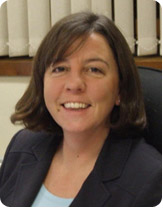EHI Interview: Kate Grimes
- 27 May 2010
 |
|
Kate Grimes |
Few NHS trusts have yet implemented care records systems. Kate Grimes, the chief executive of Kingston Hospital NHS Trust, has now done so three times; twice over with Cerner. She says she’s “getting better.”
Speaking of Kingston’s November implementation of Cerner Millennium, Grimes says it has “gone remarkably well, when you think of the scale of what has been achieved.” More than 3,000 staff are now using the system.
“Cerner is running in A&E, theatres, and maternity,” Grimes tells E-Health Insider. “We have order communications, smart cards, role-based access, a patient administration system linked to the NHS Spine, appointments linked to Choose and Book, integration with PACS, scheduling, real time bed state views – and a new management information system. We’ve taken on a lot.”
Yet, she says, the big positive about Cerner is that it is one integrated system; “it’s not just glued together by interfaces.”
Benefits of a common system
The South West London trust was the first trust in the capital to go through the new BT/Cerner local implementation model. Success was essential for BT to get a new local service provider deal for London. Kingston has since been followed by St George’s Healthcare NHS Trust, and a new BT deal was signed this March.
With Millennium now live at Kingston and St George’s, Grimes says another big benefit is that much of the South West London healthcare community will share a common system. “It’s much easier for staff on rotation and its much easier to make back-office efficiencies if you are all using the same system,” she argues.
“Overall, the benefits are about speed of access to information, replacing paper test orders and results, and being able to access information at the right time and place.”
Implement on the same build you train on
Grimes clearly feels that her experience of other deployments paid dividends. “I’d already done an implementation of Cerner under the old implementation process, so I was clear what I wanted – and I got it,” she says.
This included getting the build of the system that the trust would actually use to train on. “In the previous implementation, they froze the system too early – so we didn’t get to train on the system we wound up with.”
However, there have been problems in some areas. “Reports have not been as valid on things like the 18-week wait as would like.” Indeed, Grimes says one of the biggest challenge so far has been applying the complexities of 18-week reporting to every speciality. “If any of my staff make even a single error they can wind up having an impact on 18-week RTT targets.”
Millennium needs to be more forgiving
Grimes says this has made it important to get staff to use an unforgiving Cerner system the right way. “The greatest effort has gone into supporting staff in doing what they need to do with the system 100% of the time. This has included providing very detailed training and support to staff.”
She explains: “It’s very easy to make an error in Cerner Millennium – and when you make an error it doesn’t always tell you. It’s not always intuitive.” So while many staff pick up the system very quickly, others “struggle” and need that intense support.
Asked what she’d change, Grimes says: “It’s about making improvements to Cerner so it’s not so easy to make mistakes. It can be unforgiving to use.”
Constant communications
Communications also played a vital role in the project. “We did an email update each day; identifying issues, asking people to do things and giving them feedback.” Throughout the period, Grimes says she had on-screen issue alerts pop-up every time she switched on her PC. But she emphasises the need for the personal touch.
“Change on this scale is a really stressful thing for people. You need to support them and their self-esteem.”
This requires involvement from the top of an organisation. “It’s taken a lot of my time and attention, which has ranged from walking the floor over go-live to setting expectations.”
Quickly tackle bottlenecks
Another of Grimes’ keys to success is to “identify bottlenecks before they became major problems.” At Kingston, this included closely tracking the number of referrals made using the old system against the number of referrals made on the new one.
“We knew exactly what keystrokes people needed to be doing, down to individual clinics on a day by day basis. So we were able to go to clinicians and say ‘you haven’t filled in codes for this patient, or clinic, what’s the problem’.”
Focus on data migration
There will still be surprises. “The thing that caught us by surprise this time was data migration; which didn’t go as well as we wanted it to go,” Grimes says.
“There was a problem with Choose and Book where clinic slots were shown as empty when they might already have patients booked in. So we found, at times, that there were problems with clinicians double-booking into clinic slots that Choose and Book was showing as empty.”
As a result, patients were coming in for appointments that weren’t being shown on the Cerner system. “For a few weeks it was really difficult,” recalls Grimes.
The Kingston CEO says many clinicians made heroic efforts – doing double clinics or coming in on days off – to see patients who had shown up unexpectedly. Patients had good cause to be frustrated, she admits. “Our patient experience was not what I’d want it to be.”
Next up, discharge summaries
With Cerner now in place , the trust is now working to introduce electronic transfer and discharge summaries in May; a move that will replace the paper summaries that can take days to reach to reach GPs. “This is our solution, developed with BT, Cerner and our pathology systems provider.”
And after discharge summaries, the next big target will be e-prescribing; though the when and how of this is still being worked out by the London Programme for IT.
IM&T a ‘necessary investment’
Summing up, Grimes says IM&T must be seen as an investment by NHS leaders. “It is definitely an investment necessary for modern healthcare. We just couldn’t have carried on with the system we had.”
Asked what she’d do differently if she had to oversee another implementation, Grimes says without hesitation: “spend more time on data migration.”




